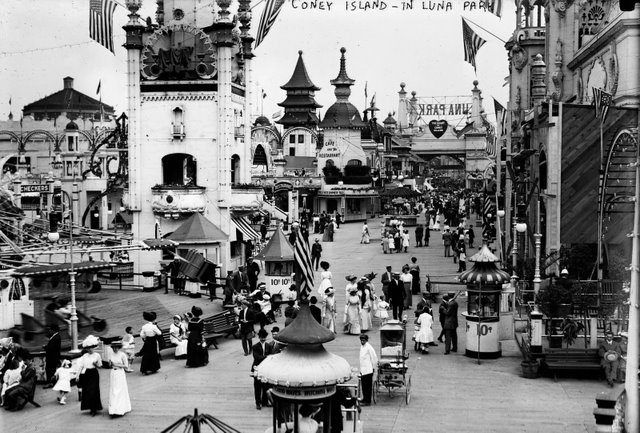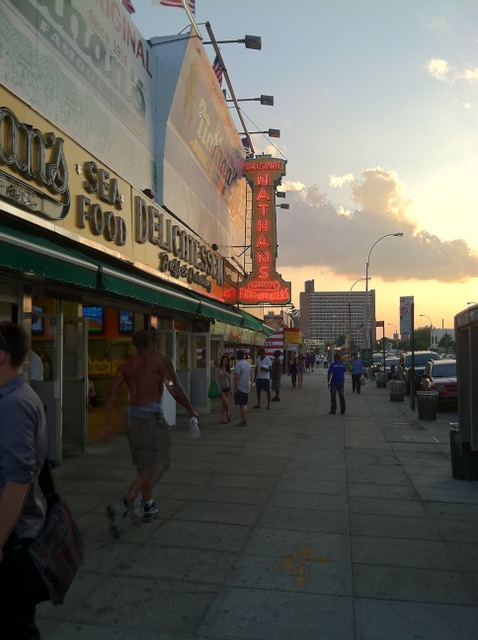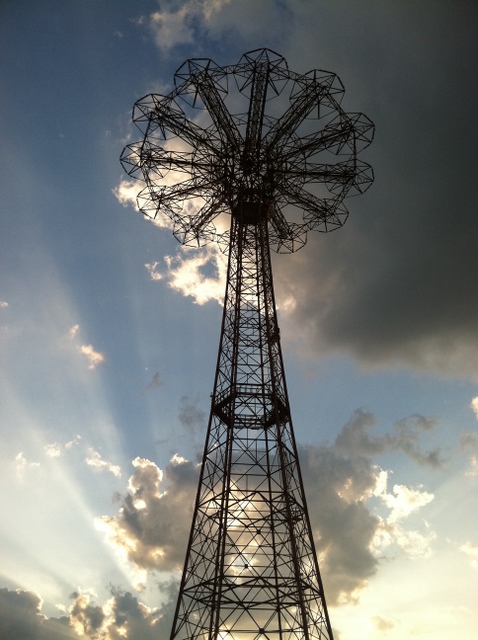Coney Island, 1910s, as it looked in my great-grandparent’s time. Photo from Library of Congress.
A few weeks ago, thanks to the NY metro chapter of the APA student representative council, I got the opportunity to attend a tour of Coney Island’s redevelopment by an EDC employee and Columbia alum. Aside from being informational, my trip to Coney Island was a personal one, as it marked the first time any member of my family has stepped foot on Coney Island since 1971, when they were forced out by new housing developments. It all began in 1911, when my family settled in Coney Island, where they would remain for three generations.
According to an old family legend, sometime around 1916, my great-grandfather, Jacob Goldklang, then a 19-year-old Jewish Austrian immigrant and Coney Island apple peddler, was approached by his friend Nathan Handwerker with a business proposition. Like my great-grandfather, Handwerker was a 20-year-old Jewish Austrian immigrant working in a local restaurant. He proposed that the two of them open their own business on the Coney Island boardwalk. The subway had just reached Coney Island and visitors were flocking to the boardwalk in droves to escape the summer heat. Coney Island was busier than ever, assuring that there would be no shortage of customers. Jacob considered the proposal, but being a religious man, he knew this business would mean working on Saturday, the Jewish Sabbath, and declined his friend’s offer.
Sometime later, an ambitious Nathan Handweker opened up a 5-cent hotdog stand on Coney Island with his wife and called it, perhaps somewhat prematurely, “Nathan’s Famous”. He undersold his competitors by a nickel, and the shop soon became a local landmark, quickly living up to its name. As Governor Nelson Rockefeller put it, “No man can hope to be elected in his state without being photographed eating a hot dog at Nathan’s Famous.” On Independence Day the year it opened, four immigrants decided to settle an argument about who was the most American by having a Nathan’s hotdog eating contest, or so the legend goes. The rest, as they say, is history. Whether the stand might have been called “Nathan and Jacob’s Famous” is purely my own imagination, but one thing is certain: I am not heir to a hotdog fortune. I might even be bitter about it if their French fries weren’t so damn good.
While it’s impossible to know what actually happened, the 1930 Census shows Jacob Goldklang and Nathan Handwerker living around the corner from one another on the very same block. They undoubtedly went to the same synagogue on 25th Street, where my great-grandfather would one day become president. Today, the site of the enormous 1924 synagogue is occupied by a housing development, a lost relic of Coney Island’s once-thriving Jewish population. Census records show every family on the block spoke Yiddish. Nathan was listed a “Standkeeper” of a “luncheonette” while Jacob was an “Operator” of “Cloaks,” — a coat-maker in Manhattan’s garment district. It was working there that he met a young Jewish seamstress named Frances, whom he would later marry.
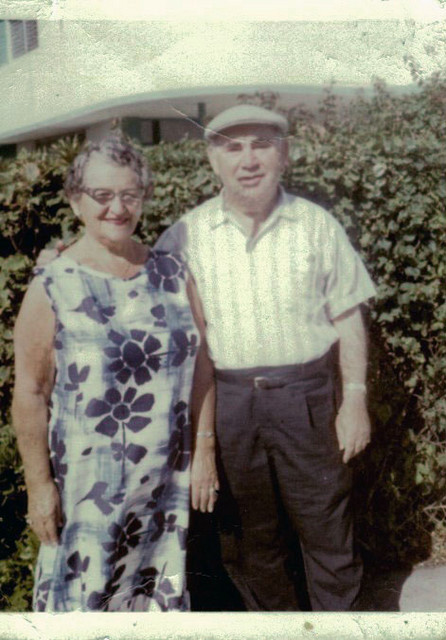 My great-grandparents, Frances and Jacob Goldklang, in their later years
My great-grandparents, Frances and Jacob Goldklang, in their later years
Together Jacob and Frances would raise three children on Coney Island, two boys and a girl- my grandmother, Roslyn, born in 1924. The beautiful Spanish-Colonial revival Childs Restaurant had just opened on the boardwalk at the end of their street. She was born just one year before the first long-lived roller coaster, “The Thunderbolt” opened on Coney Island. “The Tornado” and “The Cyclone” would follow in 1926 and 1927. Coney Island was thriving. Of the dozens of wooden roller coasters that graced Coney Island over the years, only the Cyclone remains. (The Tornado was destroyed by arson in 1977 and the Thunderbolt was recently demolished in 2000).
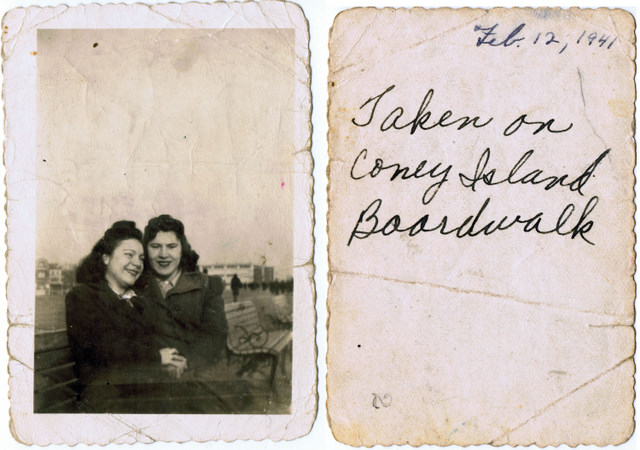 My grandmother Roslyn Goldklang (right) with her friend Buella Koppel
My grandmother Roslyn Goldklang (right) with her friend Buella Koppel
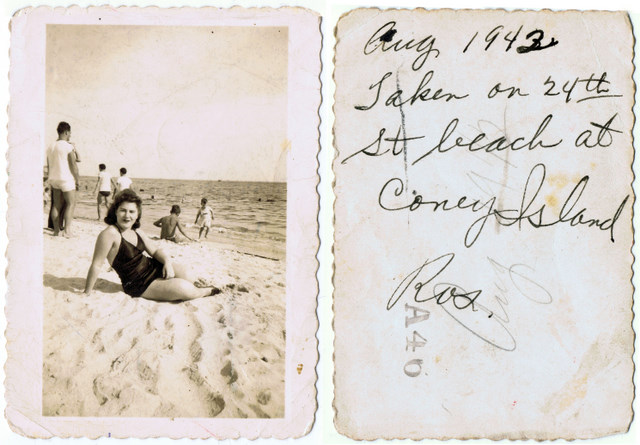
My grandmother on the beach as a teenager
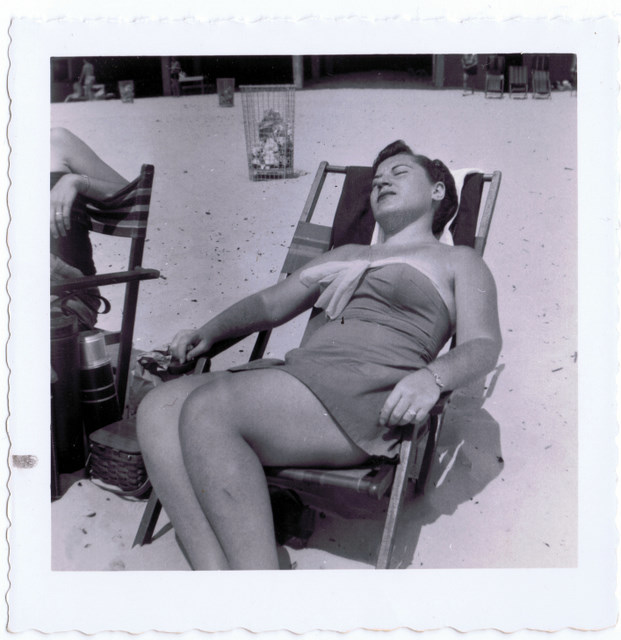 My grandmother Roslyn getting some sun on the beach at Coney Island, mid 1950s.
My grandmother Roslyn getting some sun on the beach at Coney Island, mid 1950s.
Roslyn would live in Coney Island for nearly 50 years and watch the area decline from the amusement paradise it was during her childhood. In her teenage years, Coney Island was still the entertainment destination it had been in her parent’s time. She watched the construction of Parachute Jump, the so-called “Eiffel Tower of Coney Island” in Steeplechase Park in 1941, surpassing the 1920 Wonder Wheel as Coney Island’s tallest landmark.
Newsreel footage from the 1940s (well worth watching here) called Coney Island the “World’s Greatest Fun Frolic” and shows beaches teeming with an unbelievable amount of people. Roslyn must’ve joined in on the fun, though she surely stuck to the sand and boardwalk since despite growing up so close to the ocean, she never learned to swim.
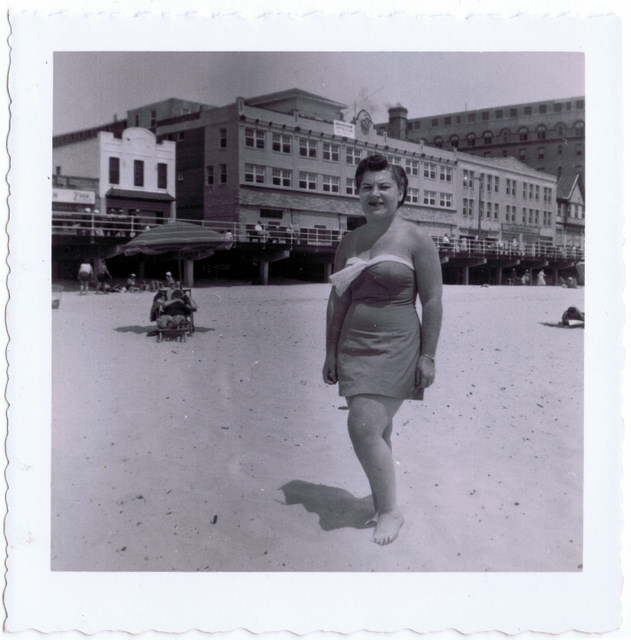 My grandmother Roslyn, in Coney Island. This was likely taken by my grandfather shortly after they were married in 1953
My grandmother Roslyn, in Coney Island. This was likely taken by my grandfather shortly after they were married in 1953
However, because of air conditioning, automobiles, and increased ability to travel, visitorship at Coney Island began to decline following the closing of Luna Park after World War II, right about the time my grandmother met a returning soldier named Abe Wallach and started their own family on Coney Island. In a 1927 four-family house that her father Jacob now owned on 35th Street between Neptune and Mermaid Avenue, across from PS. 188, the three generations lived under one roof.
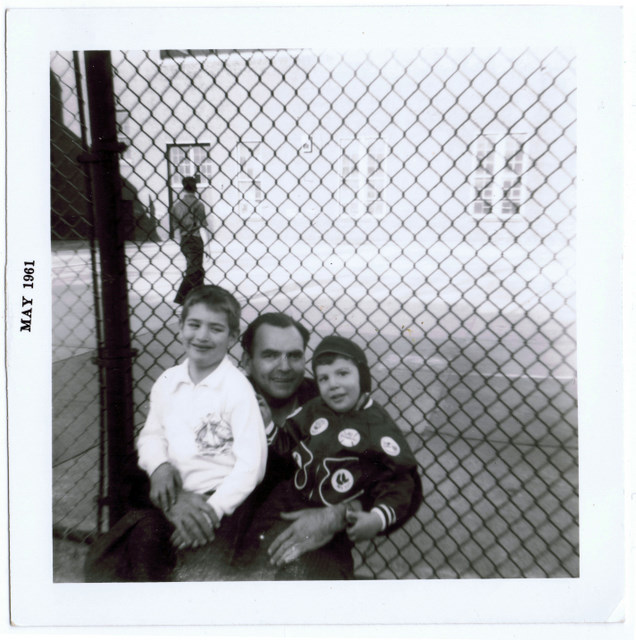 My dad Art (right) with his father and his brother Irwin. Taken in front of their home in Coney Island. PS 188 is visible in the background.
My dad Art (right) with his father and his brother Irwin. Taken in front of their home in Coney Island. PS 188 is visible in the background.
By the time my dad Arthur entered the picture in 1959, Coney Island was no longer the amusement destination it had been, but it was still a residential neighborhood. In the days before video games, my dad fondly remembers playing stoopball, foursquare, tops, an intense version of tag called “Ringolevio” which required dozens of kids, and “coop-ball”- an inventive version of stick-ball played in the three-sided courtyard, or “coop,” of PS 188. He often recounts how my grandmother would “schlepp” him and my uncle Irwin down to the beach, every single day during the summer, where they would play by the shore, and eat homemade egg-salad sandwiches, that became unavoidably sandy. For an occasional treat, they would get a knish — a Jewish snack with a crust and a potato filling — from the boardwalk.
When he was a little older, my dad would ride his bike down the entire length of the boardwalk with his friends to Famous Nathan’s for those famous crinkle-cut French fries served a paper cone with a wooden fork. As the cone did not allow for adequate ketchup distribution, the proper Coney Island etiquette required that they be dumped in the bottom of the paper bag with the top torn off, and then covered in ketchup. (The hotdogs were off-limits; they were too un-kosher). At this end of the boardwalk he would look up in sheer terror at the “enormous” roller coasters he never dared ride.
As part of large-scale urban renewal in the 1960s, Robert Moses began demolishing blocks for low-income housing projects. It was during his childhood, my dad recalls, that the neighborhood began to change. Before he started at PS 188, Steeplechase Park, Coney Island’s remaining amusement park, had shut down. The once-packed Coney Island synagogue on 25th street was almost empty on holidays. The parachute jump closed down in 1968. Childs Restaurant had been closed since before he was born, and many more stores on the boardwalk shut their doors. The neighborhood began to empty out as blocks were leveled for NYCHA towers. Before the projects were occupied, my dad and the remaining neighborhood kids took advantage of the new “futuristic” playgrounds built for towers. After Jacob passed away in 1965, my great-grandmother “Fran” became the owner of the house across from PS 188. Nathan Handwerker would move to Florida and outlive him by nearly a decade, although whether they remained friends throughout their lives is unknown.
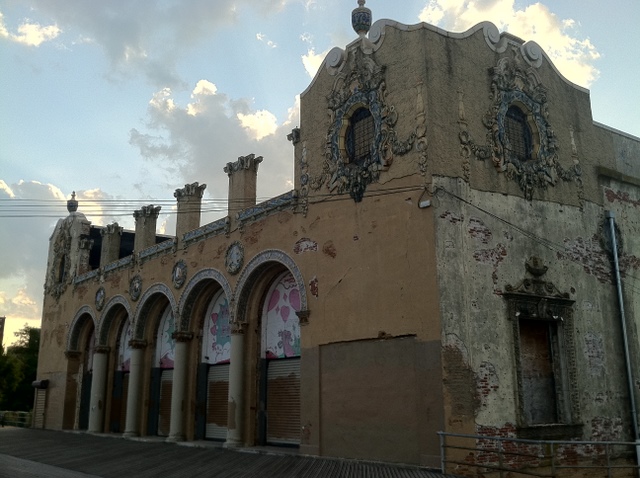 Child’s Restaurant. Photo by Alex Wallach
Child’s Restaurant. Photo by Alex Wallach
Eventually, the city decided that 35th street would be the next site of housing projects, and made an offer to buy their house. Great Grandma Fran refused. I like to think of her standing up to Robert Moses, a staunch opponent to the large scale urban renewal of the era. More likely she was just the family matriarch, defending not only her home, but the home of her daughter, son-in-law, and young grandsons. As a young girl, she was forced out of her native Austria, and was not easily going to be forced from her home in America. More and more of the neighbors gave in, but despite repeated offers, Fran held on. Eventually, it became too much. Ultimately, Fran accepted the city’s lowball offer for the house, and the family packed their bags and moved to a house in Rego Park, Queens in 1971.
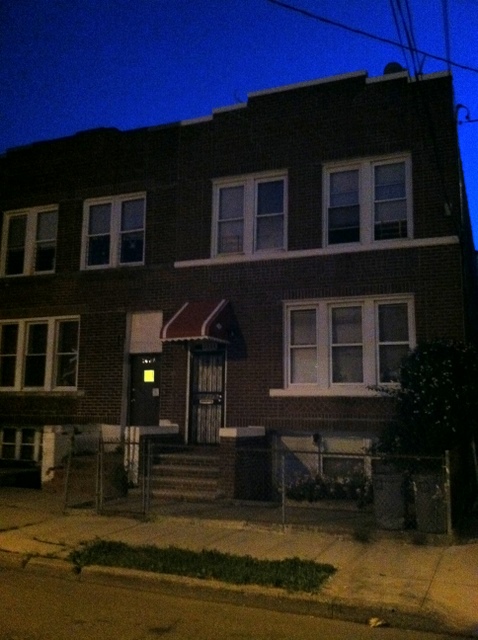 The house where my dad grew up, on 35th Street. Photo by Alex Wallach.
The house where my dad grew up, on 35th Street. Photo by Alex Wallach.
Ironically, no towers were ever built there. In a strange twist of fate, my great-grandma Fran was outlasted by the house the city was determined to demolish. She lived to the ripe old age of 97, and was the only one of my great-grandparents that I ever met. A few weeks ago I made the pilgrimage to 35th Street, where the house she fought to save – my dad’s childhood home – still stands across the street from PS. 188- the school he never graduated.
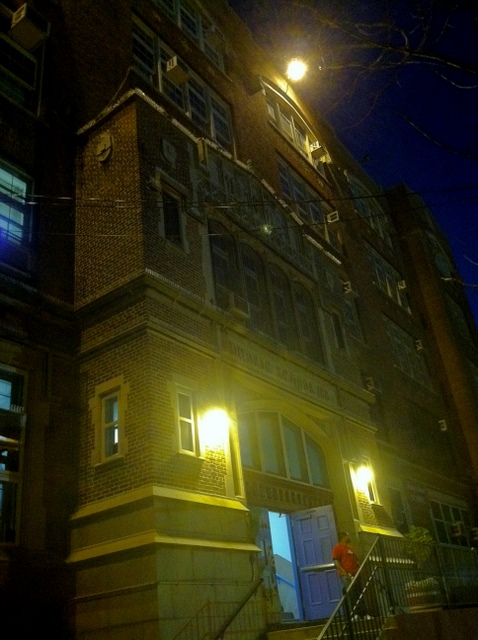 P.S. 188, across the street from the house on 35th Street. Photo by Alex Wallach.
P.S. 188, across the street from the house on 35th Street. Photo by Alex Wallach.
Today, the city has adopted a comprehensive plan to redevelop Coney Island, which still suffers from major challenges. Unemployment in the neighborhood is almost twice as high as the rest of the city. The shrinking neighborhood of 50,000 consists of mostly NYCHA properties, vacant property, and is lacking in diversity, basic retail, and services. One of the city’s major initiatives has been re-branding Coney Island, so that New Yorkers see it as the amusement destination it once was. Subway posters advertising the reopening of Luna Park exclaim, “The fun is back in Coney Island!” The fun may be back in Coney Island, but the marks left by years of decline have not quite left yet. Homeless people, some shouting obscenities, walk the boardwalk with beachgoers. The decrepit Childs Restaurant, once used as a roller rink, sits boarded up again. In June, a gang shooting on the nearby Brighton Beach boardwalk killed a teenage girl. Yes, Coney Island is still a little rough around the edges. But the city believes it’s a diamond in the rough, and is determined to make it great once again.
The city’s revitalization plan calls for year-round activity through new entertainment, retail and mixed-income residential development. Many of Coney Island’s historic icons, like Childs Restaurant, the Wonder Wheel, the Cyclone, and the defunct Parachute jump are all to be preserved, while new amusements are planned in a 27-acre rezoned Amusement and Entertainment district. The plan also calls for up to rezoning for 5,000 units of housing, 6,000 jobs, and $14 billion in economic activity in the next 30 years. Several capital improvements are also planned, including improved parking and transportation, new pedestrian plazas, and a restored historic Carousel. Community outreach also plays a role in the redevelopment, with job readiness workshops, career fairs, student competitions, and a much-needed community center in the works.
Walking around Coney Island, it’s impossible for me not imagine the boardwalk as it must have looked at its prime in my grandmother’s teenage years. Thanks in part to historic preservation, landmarks like the Parachute Jump and the Cyclone are reminiscent of the Coney Island that has captured the imagination of visitors for generations. It’s also impossible not to imagine a better, brighter future for Coney Island. Despite is problems, it’s an area with so much potential, that is such a part of the spirit and culture of New York. The beach is absolutely beautiful, amusement rides – new and historic- thrill people of all ages, and original Nathan’s still makes world-famous hotdogs- though I still prefer their French fries. It’s undeniable that Coney Island still has so much going for it, and may be poised for a come back. One day, I hope to be able to pass on our family history to future generations and show them a beautiful, vibrant, restored Coney Island, and hopefully, if we’re lucky, a house on 35th street across from PS. 188.
Next, read about 27 Secrets of Coney Island.






